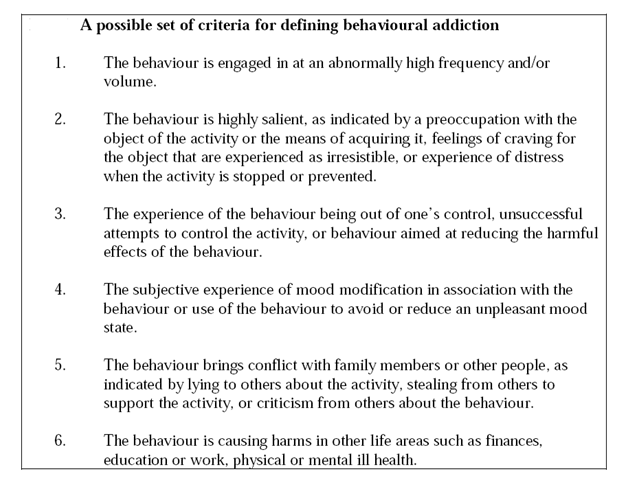Behaviour Addiction
Behavioral addiction includes a compulsion to repeatedly engage in an action until said action causes serious negative consequences to the person's physical, mental, social, and/or financial well-being. Some activities which are normally performed may sometimes become so excessive that they have features similar to that of substance addiction.
It is thought that these behavior activities may produce beta-endorphins in the brain, which makes the person feel "high." Some experts suggest that if a person continues to engage in the activity to achieve this feeling of well-being and euphoria, he/she may get into an addictive cycle. In so doing, he/she becomes physically addicted to his/her own brain chemicals, thus leading to continuation of the behavior even though it may have negative health or social consequences. Others feel that these are just bad habits.
When does normal behavior become an addiction?
Normal behavior becomes an addiction when:
- They increase and become repetitive
- recurrent failure to control the behaviour;
- Need to increase the behavior to achieve the same pleasure as before
- continuation the behaviour despite significant harmful consequences
- The person gradually gets preoccupied with these activities neglecting his/her other aspects of life
- Giving up or your social life, work and responsibilities due to the behavior
- Distress, anxiety, restlessness, or irritability if unable to perform the behavior
The type of behaviors which some people have identified as being addictive include gambling, food, sex, viewing of pornography, use of computers, playing video games, use of the internet, work, exercise, spiritual obsession (as opposed to religious devotion), cutting, and shopping.

How are behavioral addictions similar to substance addiction?
There are many similarities in the neurobiology of behavior and drug addictions. One of the most important discoveries of addictions has been the drug based reinforcement and, even more important, reward based learning processes. Several structures of the brain are important in the conditioning process of behavior addiction.
One of the major areas of study includes the region, called the amygdala, which involves emotional significance and associated learning. Research shows that dopaminergic projections to the amygdala facilitate a motivational or learned association to a specific behavior. The cycle that is created is considered the dopamine reward system.
Dopamine neurons take a role in the learning and sustaining of many of the behaviors we acquire. Research specific to Parkinson’s disease has led to identifying the intracellular signaling pathways that underlie the immediate actions of dopamine. The most common mechanism of dopamine is to create addictive properties along with certain behaviors. There are three stages to the dopamine reward system: bursts of dopamine, triggering of behavior, and further impact to the behavior. Once electronically signaled, possibly through the behavior, dopamine neurons let out a ‘burst-fire’ of elements to stimulate areas along fast transmitting pathways. The behavior response then perpetuates the striated neurons to further send stimuli. The fast firing of dopamine neurons can be monitored over time by evaluating the amount of extracellular concentrations of dopamine through micro dialysis and brain imaging. This monitoring can lead to a model in which one can see the multiplicity of triggering over a period of time. Once the behavior is triggered, it is hard to work away from the dopamine reward system.
Behaviors like gambling have been linked to the new found idea of the brain’s capacity to predict rewards. The reward system can be triggered by early detectors of the behavior, and trigger dopamine neurons to begin stimulating behaviors. But in some cases, it can lead to many issues due to error, or reward-prediction errors. These errors can act as teaching signals to create a complex behavior task over time.
Behavioral addictions have similarities with substance dependence like:
- Recurrent failure (pattern) to resist impulses to engage in specific behavior
- Frequently engaging in these behaviors to a greater extent or over a longer period of time than intended
- Persistent desire or unsuccessful efforts to stop, reduce, or control these behaviors
Common Characteristics among Addictive Behaviours
There are many common characteristics among the various addictive behaviours:
- The person becomes obsessed (constantly thinks of) the object, activity, or substance.
- They will seek it out, or engage in the behaviour even though it is causing harm (physical problems, poor work or study performance, problems with friends, family, fellow workers).
- The person will compulsively engage in the activity, that is, do the activity over and over even if he/she does not want to and find it difficult to stop.
- Upon cessation of the activity, withdrawal symptoms often occur. These can include irritability, craving, restlessness or depression.
- The person does not appear to have control as to when, how long, or how much he or she will continue the behaviour (loss of control). (They drink 6 beers when they only wanted one, buy 8 pairs of shoes when they only needed a belt, ate the whole box of cookies, etc).
- Often denies problems resulting from his/her engagement in the behaviour, even though others can see the negative effects.
- Person hides the behaviour after family or close friends have mentioned their concern. (Hides food under beds, alcohol bottles in closets, doesn't show spouse credit card bills, etc).
- Many individuals with addictive behaviours report a blackout for the time they were engaging in the behaviour (don't remember how much or what they bought, how much the lost gambling, how many miles they ran on a sore foot, what they did at the party when drinking)
- Depression is common in individuals with addictive behaviours. That is why it is important to make an appointment with a physician to find out what is going on.
- Individuals with addictive behaviours often have low self esteem, feel anxious if they do not have control over their environment, and come from psychologically or physically abusive families.
Preventing and treating behavioural addictions
Ways of preventing and treating behavioural addictions that are likely to be most common in coming decades are summarised as follows.
Ways of managing behavioural addiction
|
Potentially effective forms of treatment will in many cases be similar to those for substance addiction, including psychological treatments such as cognitive behaviour therapy. The involvement of family members is recommended. The central element of treatment is the correction of erroneous perceptions about addiction, problem-solving training, social-skills training, and relapse prevention.
